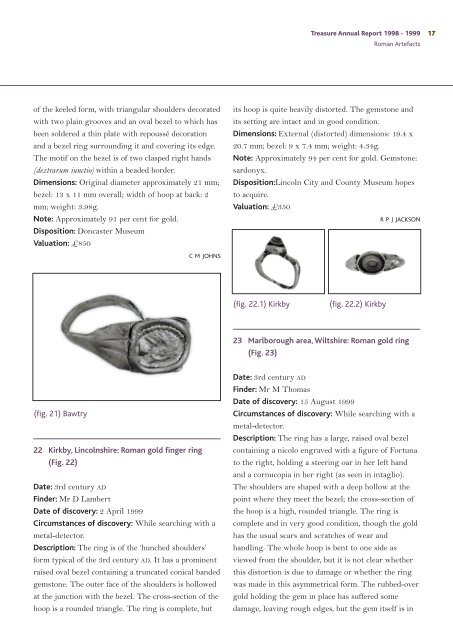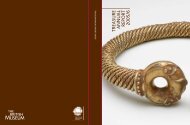Treasure Annual Report 1998-1999 - Portable Antiquities Scheme
Treasure Annual Report 1998-1999 - Portable Antiquities Scheme
Treasure Annual Report 1998-1999 - Portable Antiquities Scheme
Create successful ePaper yourself
Turn your PDF publications into a flip-book with our unique Google optimized e-Paper software.
of the keeled form, with triangular shoulders decorated<br />
with two plain grooves and an oval bezel to which has<br />
been soldered a thin plate with repoussé decoration<br />
and a bezel ring surrounding it and covering its edge.<br />
The motif on the bezel is of two clasped right hands<br />
(dextrarum iunctio) within a beaded border.<br />
Dimensions: Original diameter approximately 21 mm;<br />
bezel: 13 x 11 mm overall; width of hoop at back: 2<br />
mm; weight: 3.98g.<br />
Note: Approximately 91 per cent for gold.<br />
Disposition: Doncaster Museum<br />
Valuation: £850<br />
(fig. 21) Bawtry<br />
22 Kirkby, Lincolnshire: Roman gold finger ring<br />
(Fig. 22)<br />
C M JOHNS<br />
Date: 3rd century AD<br />
Finder: Mr D Lambert<br />
Date of discovery: 2 April <strong>1999</strong><br />
Circumstances of discovery: While searching with a<br />
metal-detector.<br />
Description: The ring is of the ‘hunched shoulders’<br />
form typical of the 3rd century AD. It has a prominent<br />
raised oval bezel containing a truncated conical banded<br />
gemstone. The outer face of the shoulders is hollowed<br />
at the junction with the bezel. The cross-section of the<br />
hoop is a rounded triangle. The ring is complete, but<br />
<strong>Treasure</strong> <strong>Annual</strong> <strong>Report</strong> <strong>1998</strong> - <strong>1999</strong> 17<br />
17<br />
Roman Artefacts<br />
its hoop is quite heavily distorted. The gemstone and<br />
its setting are intact and in good condition.<br />
Dimensions: External (distorted) dimensions: 19.4 x<br />
20.7 mm; bezel: 9 x 7.4 mm; weight: 4.34g.<br />
Note: Approximately 94 per cent for gold. Gemstone:<br />
sardonyx.<br />
Disposition:Lincoln City and County Museum hopes<br />
to acquire.<br />
Valuation: £350<br />
(fig. 22.1) Kirkby (fig. 22.2) Kirkby<br />
R P J JACKSON<br />
23 Marlborough area, Wiltshire: Roman gold ring<br />
(Fig. 23)<br />
Date: 3rd century AD<br />
Finder: Mr M Thomas<br />
Date of discovery: 15 August <strong>1999</strong><br />
Circumstances of discovery: While searching with a<br />
metal-detector.<br />
Description: The ring has a large, raised oval bezel<br />
containing a nicolo engraved with a figure of Fortuna<br />
to the right, holding a steering oar in her left hand<br />
and a cornucopia in her right (as seen in intaglio).<br />
The shoulders are shaped with a deep hollow at the<br />
point where they meet the bezel; the cross-section of<br />
the hoop is a high, rounded triangle. The ring is<br />
complete and in very good condition, though the gold<br />
has the usual scars and scratches of wear and<br />
handling. The whole hoop is bent to one side as<br />
viewed from the shoulder, but it is not clear whether<br />
this distortion is due to damage or whether the ring<br />
was made in this asymmetrical form. The rubbed-over<br />
gold holding the gem in place has suffered some<br />
damage, leaving rough edges, but the gem itself is in





